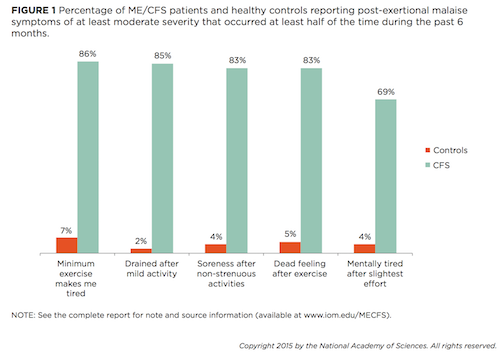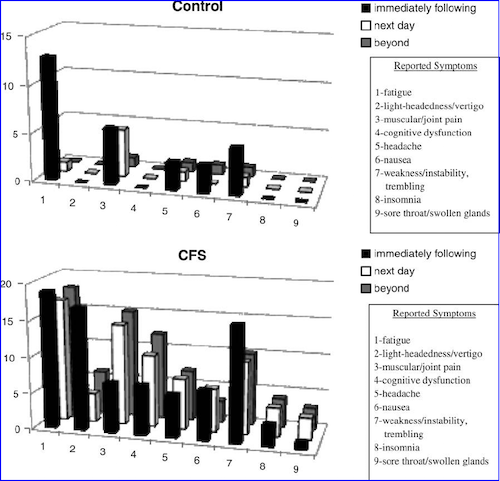Post-exertional malaise
Post-exertional malaise (PEM) is a worsening of many ME/CFS symptoms as a result of physical or mental exertion. It is often referred to as "the marker" by patients, ME/CFS organizatons, clinicians and researchers that work in the ME/CFS field. PEM can last for days to weeks after the exertion.[1][2]
Worsening symptoms include chronic fatigue, flu-like symptoms, brain fog (cognitive dysfunction), unrefreshing sleep, chronic pain, orthostatic intolerance, neurally mediated hypotension, POTS and more. "As with the severity, the exertion needed to trigger PEM theories case-by-case. For some, it might kick in after a little bit of exercise on top of a day's regular activities. For others, is incredible as it may seem, it can just take a trip to the mailbox, a shower, or sitting upright for an hour." [3][4][5][6] Onset of PEM can be delayed 24-72 hours.[7]
2015 Institute of Medicine report[edit | edit source]
This landmark report published in 2015 by the United States Institute of Medicine report, which assessed all the evidence available, concluded:
"There is sufficient evidence that PEM is a primary feature that helps distinguish ME/CFS from other conditions"
Pages 84-86 of the report describe the evidence for post-exertional malaise in ME/CFS patients.[8]
Prevalence[edit | edit source]
Symptom recognition[edit | edit source]
Notable studies[edit | edit source]
- 1999, Demonstration of delayed recovery from fatiguing exercise in chronic fatigue syndrome
- 2013, Post-exertion malaise in chronic fatigue syndrome: symptoms and gene expression, Meyer et al, 2013[9]
- 2015, Myalgic Encephalomyelitis: Symptoms and Biomarkers, Jason et al, 2015[10]
- 2015, Changes in Gut and Plasma Microbiome following Exercise Challenge in Myalgic Encephalomyelitis/Chronic Fatigue Syndrome (ME/CFS), Shukla et al, 2015[11]
Notable articles[edit | edit source]
- Suggestion to replace PEM (Post Exertional Malaise) with PAR (Post Activity Relapse), ME Blogg, 2015[12]
Talks & interviews[edit | edit source]
- 2016, Inducing Post-Exertional Malaise in ME/CFS: A Look at the Research Evidence (Peter Rowe)
- 2015, Post-Exertion Malaise: The Intersection of Biology and Behavior, Dane Cook, Solve ME/CFS[13]
- 2015, 72. Gene-expression and exercise / Gen-expressie en inspanning – dr. Lucinda Bateman (Lucinda Bateman, Science for Patients)
- 2013, CFS gene expression after exercise (part 1) (Lucinda Bateman)
- 2012, Top 10 Things You Should Know About Post-Exertional Relapse (Staci Stevens)
Possible causes[edit | edit source]
Potential treatments[edit | edit source]
Learn more[edit | edit source]
- International CFS/ME Awareness Day 2017 - What Health (PEM Definition Included) CFIDS Association of America
- Post-Exertional Malaise in Chronic Fatigue Syndrome, Jennie Spotila, Solve ME/CFS, 2010[14]
- Post-Exertional Malaise: Cause and Effect, Jennie Spotila, Solve ME/CFS, 2012[15]
- Definition of Post-Exertional Malaise, About Health, 2015[16]
- Post-Exertional Malaise Video, ME/CFS Ghost, 2016[17]
- 2016, The Exercise Intolerance in POTS, ME/CFS and Fibromyalgia Explained?
See also[edit | edit source]
References[edit | edit source]
<references>
- ↑ 1.0 1.1 Johnson, C, Health Rising: ME/CFS Symptoms, retrieved Mar 2016 Check date values in:
|access-date=(help) - ↑ 2.0 2.1 Fighting Fatigue, Post-Exertional Malaise – A Hallmark Symptom of ME/CFS, retrieved Mar 2016 Check date values in:
|access-date=(help) - ↑ What Is Post-exertional Malaise - Very Well - Adrienne Dellwo
- ↑ Post Exertional Malaise - Very Well - Adrienne Dellwo
- ↑ Chronic Fatigue Syndrome - Web MD
- ↑ PEM Series - Solve ME/CFS - Jenny Spotila
- ↑ What Health - International CFS/ME Awareness Day 2017 - CFIDS Association of America
- ↑ Institute of Medicine report pages 84-86, search term exercise
- ↑ 9.0 9.1 Meyer, JD; Light, AR; Shukla, SK; Clevidence, D; Yale, S; Stegner, AJ; Cook, DB (October 2, 2013), "Post-exertion malaise in chronic fatigue syndrome: symptoms and gene expression", Fatigue: Biomedicine, Health & Behavior, 1 (4): 190-209, doi:10.1080/21641846.2013.838444
- ↑ 10.0 10.1 Jason, LA; Zinn, ML; Zinn, MA (September 2015), "Myalgic Encephalomyelitis: Symptoms and Biomarkers", Current Neuropharmacology, 13(5): 701-734, doi:10.2174/1570159X13666150928105725
- ↑ 11.0 11.1 Shukla, SK; Cook, D; Meyer, JD; et al. (December 18, 2015), "Changes in Gut and Plasma Microbiome following Exercise Challenge in Myalgic Encephalomyelitis/Chronic Fatigue Syndrome (ME/CFS)", Plos One, 10(12), doi:10.1371/journal.pone.0145453
- ↑ 12.0 12.1 ME Blogg (December 30, 2015), Suggestion to replace PEM by PAR
- ↑ 13.0 13.1 Cook, DB (November 19, 2015), "Deciphering Post Exertion Malaise: The Intersection of Biology and Behavior", Solve ME/CFS (video)
- ↑ 14.0 14.1 Spotila, JM (2010), "Post-Exertional Malaise in Chronic Fatigue Syndrome" (PDF), Solve ME/CFS
- ↑ 15.0 15.1 Spotila, JM (May 23, 2012), "Post-Exertional Malaise: Cause and Effect", Solve ME/CFS
- ↑ 16.0 16.1 About Health (October 8, 2015), Definition of Post-Exertional Malaise
- ↑ Post-Exertional Malaise - The ME/CFS Ghost
- ↑
Nijs, J; Van Oosterwijck, J; Meeus, M; Lambrecht, L; Metzger, K; Frémont, K; Paul, L (April 2010), "Unravelling the nature of postexertional malaise in myalgic encephalomyelitis/chronic fatigue syndrome: the role of elastase, complement C4a and interleukin-1beta", Journal of Internal Medicine, doi:10.1111/j.1365-2796.2009.02178.x, PMID 20433584 Invalid
|display-authors=7(help) - ↑
Van Oosterwijck, J; Nijs, J; Meeus, M; Lefever, I; Huybrechts, L; Lambrecht, L; Paul, L (September 2010), "Pain inhibition and postexertional malaise in myalgic encephalomyelitis/chronic fatigue syndrome: an experimental study", Journal of Internal Medicine, doi:10.1111/j.1365-2796.2010.02228.x, PMID 20412374 Invalid
|display-authors=7(help) - ↑
VanNess, M; Stevens, S; Bateman, L; Stiles, TL; Snell, CR (February 2010), "Postexertional malaise in women with chronic fatigue syndrome", Journal of Women's Health, doi:10.1089/jwh.2009.1507, PMID 20095909 Invalid
|display-authors=5(help)



